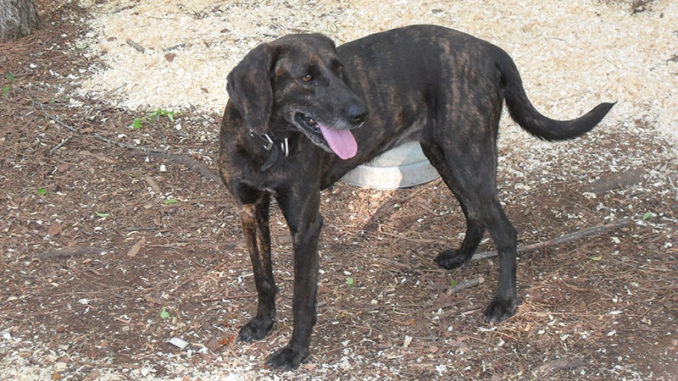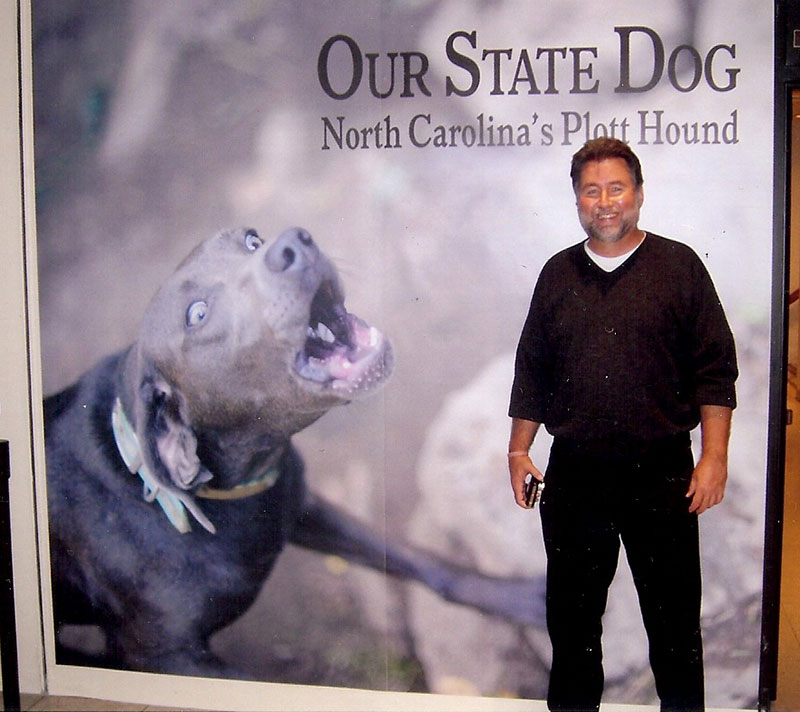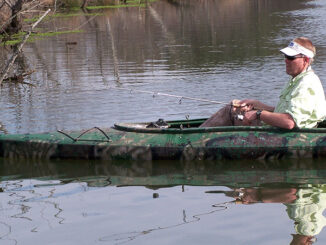
If you were tasked with designing the perfect dog for hunting dangerous big game – bears and wild boars – you would list the qualities of North Carolina’s official state dog – the Plott Hound. Bob Plott, noted chronicler of Plott Hound history, lists four main attributes of the breed: tenacity, stamina, grit and intelligence.
The history of the Plott Hound in North Carolina is an epic American story as its beginning predates the American Revolution. When he emigrated to the American Colonies from Germany in 1750 Johannes Plott, son of a gamekeeper, brought with him five hounds used to chase and bay wild boar and other big game in the Black Forest. Those five hounds were the base for the dogs known as the premier bear hound breed in America, the Plott Hound.
Johannes, with his five prized hounds, moved south from Philadelphia to what is now New Bern, NC, then headed west to present-day Cabarrus County before settling in Lincoln County near present day Maiden, NC. Along the way, he married, started a family, dropped Johannes in favor of his middle name, George, and continued breeding his select line of hunting dogs.
Western NC at the time was the Frontier. “It was rough country, still Indian country,” said Bob Plott, third great grandson of George Plott. About 1805, George’s son, Henry, took the dogs to Haywood County. “On the Frontier they were multi-purpose. They hunted and herded and protected the family. There is story after story of the dogs defending households during the Indian Wars and the Civil War.”
“Henry and his brother-in-law planted a crop of corn in what is now Dutch Cove, outside of Canton. The corn crop failed, winter was coming on, and the brother-in-law decided to return home, but Henry said he was going to stay. He credited the dogs with getting him through the winter, helping him find food and hunting.”
That spring Henry, Bob Plott’s great-great uncle, followed the old Rutherford Trace Trail down to present-day Waynesville and the Hazelwood area where he settled. He had a big farm and a big family. He hunted and trapped and sold brandy, Plott said.
Official state dog
It was here that the Plott Hound story took life. Just west of Maggie Valley a sign at an overlook on the Blue Ridge Parkway proclaims: “Before you lies the massive Plott Balsam Range. On one of its Eastern slopes, Henry Plott, a German immigrant’s son, made his home in the early 1800s.” A bronze statue of a Plott Hound stands in the Hazlewood section of Waynesville with a plaque that proclaims the Plott Hound is “one of only four breeds known to be of American origin.”
 Over the years the Plott Family and friends who kept Plott Hounds pretty much bred them close to the line, keeping their natural instincts intact, Bob Plott said. Because of their lineage they were perfectly suited for hunting bears in the mountains of Western NC and beyond. Some were used to hunt big wild boars in the mountains and also in the lowland swamps of the Carolinas. And, they could also help fill a hunter’s bag with squirrels and provide a successful night treeing raccoons, if necessary.
Over the years the Plott Family and friends who kept Plott Hounds pretty much bred them close to the line, keeping their natural instincts intact, Bob Plott said. Because of their lineage they were perfectly suited for hunting bears in the mountains of Western NC and beyond. Some were used to hunt big wild boars in the mountains and also in the lowland swamps of the Carolinas. And, they could also help fill a hunter’s bag with squirrels and provide a successful night treeing raccoons, if necessary.
Outdoor writers had been publishing articles on the Plott Hound since the 1920s, Plott said, in magazines like Field and Stream and in The New York Times.
“These articles made the breed nationally famous and played a big part in the United Kennel Club recognizing the breed in 1946, as did famous politicians, athletes and businessmen coming from all over the United States to hunt in the Smokies. They often later ordered dogs of their own or spread the word to others who did,” said Plott. “The American Kennel Club came on board in the late 1980s, and today every major kennel club in the world recognizes these superb, multi-purpose animals.”
In 1989 the North Carolina General Assembly designated the Plott Hound as the official state dog, citing the hound as a “legendary bear dog known as a most courageous fighter and tenacious tracker, as well as a gentle and extremely loyal companion to the hunters of North Carolina.”
Bob Plott can proudly produce pedigrees showing seven generations of Plott Hounds back to 1946. He also has another record of the breed that goes back even further.
“I have photographs of Plott Hounds all the way back to 1870 and those dogs look exactly like my dogs today,” he said.




Be the first to comment